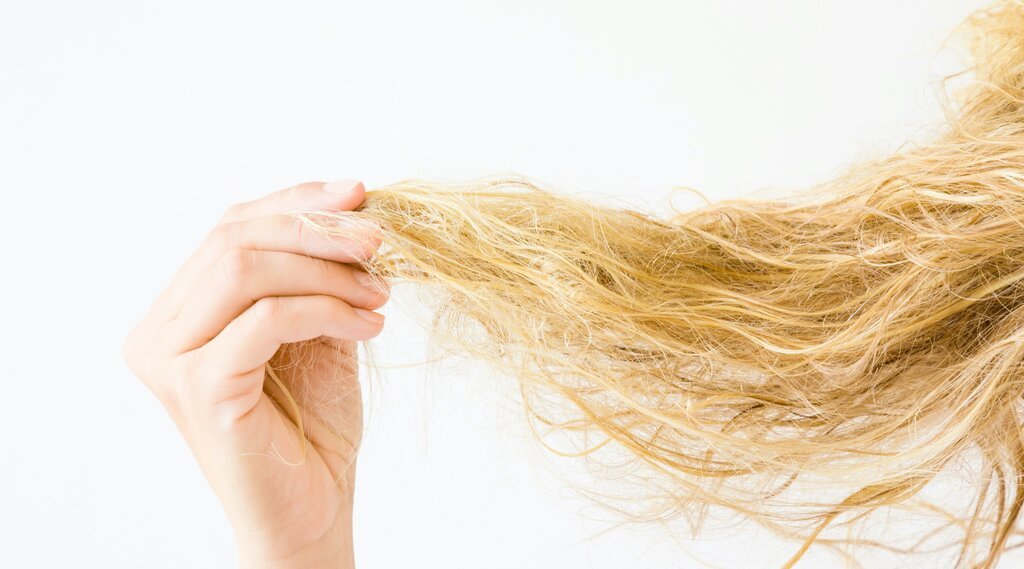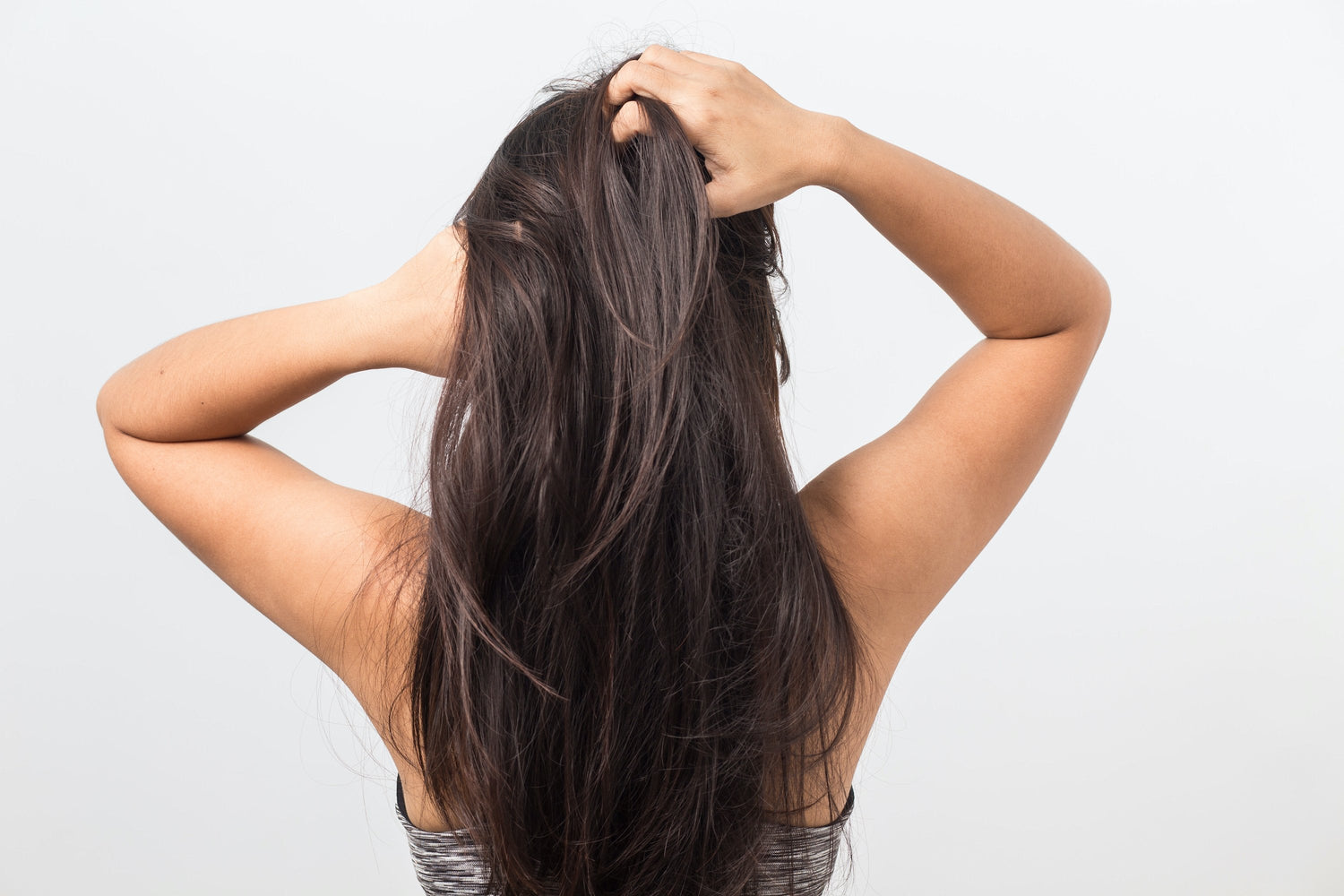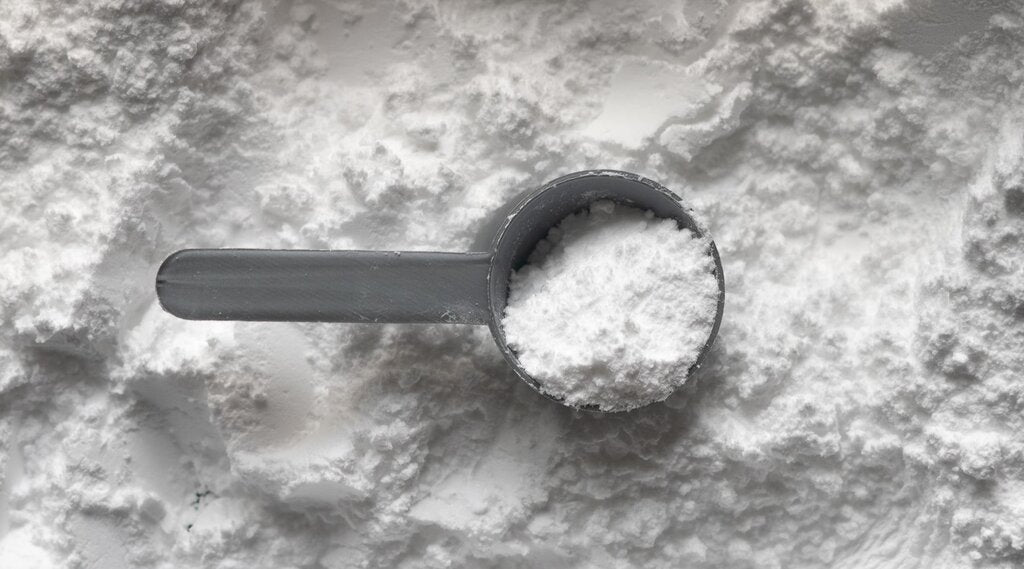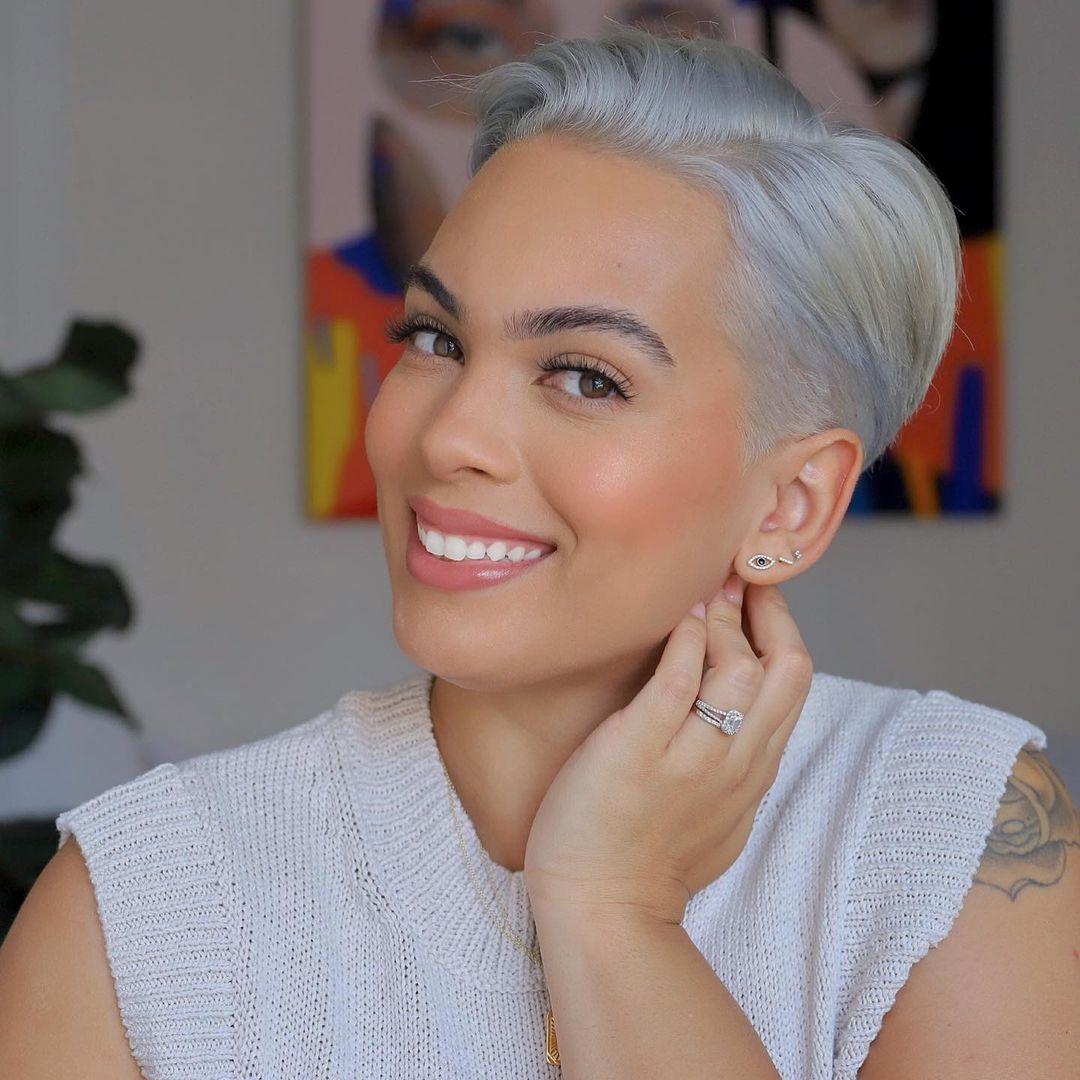How can hair be healthy if it's dead? Although it’s ‘dead,' it’s there’s still ways you can improve your hair’s health. Sure, hair is an accumulation of dead protein cells, so, it's not “alive”. There are no live nerves in the hair shaft - only at the hair follicle where the hair emerges from the scalp. However, just like you can restore an old car, there are things you can do to help restore hair and maintain hair health. Hair should be cared for through proper maintenance. Dry hair, split ends, fried hair, dull hair, fine and limp hair and thinning hair can all be helped through proper hair care and prioritizing scalp care. Here’s everything you need to know about what damaged hair looks like and tips to help repair damaged hair.
What is the Structure of Hair?
Before understanding what damaged hair looks like, it's helpful to understand the structure of healthy hair. We can then better understand the signs of damaged hair, how hair becomes damaged and how to fix damaged hair. In short, hair is made of four parts:
A healthy hair cortex leads to stronger hair and less hair breakage.
The cortex of the hair is where your keratin lives. Keratin protein is important when it comes to hair damage and hair health. The keratin protein lives in your hair cortex with other lipids. Keratin is a type of protein that can be manipulated by chemicals such as for a perm or relaxant to either curl the hair or straighten it. Keratin hair treatments were invented to repair the keratin damage you may have but may actually be damaging to your hair. When you bleach or dye your hair, you are inserting certain chemicals into the cortex to manipulate the melanin that exists there, as well. In the cortex is also where bond builders work. You can read more about the importance of hair bonding treatments here.

A healthy hair Cell Membrane Complex (CMC) reduces dry hair.
The cell membrane complex is where your hair hydration lives. It is composed of lipids that are "sticky" and keep the cortex and the cuticle together. When the cell membrane complex is exposed, you lose hydration and expose the cortex to cause further damage as it protects that important innermost layer of the hair shaft. We will talk more later about what damage to the cell membrane complex looks like, but just assume that it is very important to the health of your hair shaft.
A healthy hair cuticle leads be better hair shine and color longevity.
The cuticle is made up of layers of hard scales that lay down flat to protect the rest of the hair shaft. When the hair cuticle is flat, there is less hair tangles, hair has added shine and hair color is more vibrant. The hair cuticle scales can lift depending on the damage and can cause several of the symptoms of hair damage. Most hair care products are designed to manipulate, coat, mask, or otherwise temporarily improve the look of the cuticle of the hair. While the cuticle is made up of dead cells, their attachment to the cell membrane complex and their ability to lay down and be flexible is very important to making hair look healthy and beautiful.

The hair medulla is not always present.
The medulla is in the very center of the cuticle and may not exist in all hair types. It is particularly prevalent in course, darker hair and gray hair. It contains a less organized mixture of air and cortex cells. It doesn't serve any known purpose and may even contribute to an uneven distribution of strength over the hair shaft. Often products do not have anything to do with the medulla because of its lack of consistency in types of hair and because keratin and bonds in the hair exist in the cortex, cell membrane complex, and cuticle.
What does damaged hair look like?
Many hair problems like hair breakage, dull hair, brittle hair, dry hair, tangly hair, frizzy hair, and straw-like hair are signs and symptoms of hair damage. Here are eight of the most common signs of hair damage, followed by deeper explanations as to why hair gets damaged.
- Frizzy hair
- Tangles easily
- Lacks elasticity
- Split ends that won't go away even after trimming
- Dull hair that lacks shine
- Dry hair
- Breaks off easily - with hair blisters leading that lead to breakage
- Brittle and straw-like hair with inconsistent textures
Damaged hair is frizzy.
Frizzy hair is often described by people as unmanageable, unruly hair they can't control. While it might be difficult to control, understanding why hair gets frizzy is incredibly helpful for managing it. Frizz is caused by hair porosity. When hair absorbs water, it causes the hair shaft swelling. Excessive or repeated chemical treatment, grooming habits, and environmental exposure produce changes in hair texture, increases hair porosity and if extreme can result in hair breakage. These changes can be seen microscopically as “weathering” of the hair shaft and contribute to tangling, and frizzing. Weathering is the progressive degeneration from the root to the tip of the hair. Normal weathering is due to daily grooming practices. When the hair is extremely weathered and chemically treated, there may be scaling of the cuticle layers, removal of the 18-MEA and cuticle crack. If the cuticle is removed, the exposure of the cortex and further cortex damage may lead to hair fiber fracture. The trick to managing frizz is to use products that help lay down the cuticle and limit the amount of moisture that enters into the cell membrane complex. The use of hair treatments that focus on restoring the hair's cell membrane complex help reduce hair cuticle damage and prevent hair breakage by reducing hair friction and water absorption.
Check out which of our SAVE ME FROM Hair Repair products customers have said made a huge difference on their frizz
Damaged hair tangles easily.
Tangled hair is also a sign of damage, something I would guess you didn't know. Tangly hair is a result of the cuticle of the hair shaft lifting up and then "catching" on other lifted cuticles. Now, imagine what happens when you comb through to detangle those stuck cuticles? Yep, more damage and more tangles. Keeping the cuticle healthy and laid down is essential to keeping the rest of the hair healthy.
Check out with of our SAVE ME FROM Hair Repair products was designed to prevent and repair hair that gets extra tangly
Damaged hair lacks elasticity.
The hair is naturally gifted with the ability to stretch and rebound to its original shape. This allows are our hair to stretch and flex without being broken. When hair lacks elasticity, its rigid and can completely fracture.
You can't talk about frizzy hair, tangles and reduced elasticity without talking about the hydrophobicity of hair.
What hair hydrophobicity?
Damaged hair has split ends.
The ends of your hair are the oldest parts of your hair, thus is natural to see some weathering. When the ends of your hair start to split, this can be a sign of wear and tear and can happen even if you do everything healthy for your hair. In this case, it's important to keep a healthy hair routine. Sleeping on a satin pillowcase, limited heat and using split end creams like Save Me From Chemical Conflict hair repair treatment can help.

Damaged hair is dull hair.
Ever wondered if you were bound to just have to endure "mousy" looking hair the rest of your life? Well, now that you know that dullness is a symptom of hair damage you can fix it and get that shine you miss! Dull hair is similar to tangly hair- when the cuticle is lifted up and haphazardly pointing in any direction, the shine of the hair decreases. Thus, when you take care to lay the cuticle down on the shaft, you are going to bring back your natural shine.
Damaged hair is dry.
One of the most common complaints about hair is how dry it gets. Many people want to know- how can I fix dry hair? Dry hair is a symptom of a dry cell membrane complex. When the cell membrane complex is exposed and hydration is lost, this is because of damaged cuticle and damaged lipids. Hydrating your hair means more than just applying a conditioner! It means repairing lipids, reinserting hydration, and locking it all in with some better habits and better products.
If you deal with dry hair, you might be interested in our SAVE ME FROM Thermal Obsession
Damaged hair breaks easily, leading to increased hair loss.
Hair should all have a consistent diameter from the hair's midshaft to the hair ends. If you notice the hair begin to thin, this may be due to hair breakage or haircuts requiring layers. Many people often that they are losing hair when they are actually experiencing hair breakage. Breakage occurs when the cortex of the hair is exposed, and the keratin is broken or weakened. Hair loss is often just hair breakage because the hair breaks most often in the mid-shaft (usually where you are using strong rubber bands in your hair for those buns and ponytails). When hair is exposed to high heat, the water inside the hair shaft can boil. This boiling can create a hair blister. This hair bump can eventually "pop" and cause the hair to break. Hair breakage can be very hard to fix but when holistic hair treatments are used consistently that target every layer of the hair, helping to relink bonds, restore hydrophobicity at the cell membrane complex and improve the cuticle, you can pull it off.

Damaged hair is brittle and can feel like straw.
Brittle, straw-like hair with inconsistent textures throughout the strand is often due to UV exposure, glycation, and damaging chemicals in waters like chlorine and hard water. When you sweat, your hair undergoes a process called glycation where the cuticle layers will fuse together, making it stiff and much more prone to breakage. While you want your cuticles to lay down on the hair shaft, you also want them to be flexible enough to give your hair bounce and fullness.
Never thought to protect your hair from the sun? SAVE ME FROM Sun + Sweat is now your go to sun protectant for your hair.
Hair can be damaged by single-strand knots.
A single-strand knot is when hair curls up at the ends by itself and creates a knot. Single-strand knots can break very easily. They are most common for those with naturally curly hair and coily hair. These single strand knots in hair are also known as fairy knots. To prevent fairy knots from happening, it's important to keep the hair stretched at the ends while drying. Using a hair moisturizer, braiding the hair and twisting the hair all the way down to the hair ends so that the hair doesn't shrink and wrap upon itself can help. Conditioning treatments made with cold-pressed virgin oils and humectants like those found in Save Me From Thermal Obsession Hair Repair Treatment and Heat Protectant can penetrate within the hair, reduce hair swelling while improving proper hair moisture.
How does hair get damaged?
We have identified six major sources of hair damage to combat. Five of these sources are due to what we do to our hair, and the sixth is due simply to a process we all go through. When keratin is restructured, hydrolipidic film disappears, and cuticle scales fall off is when hair is damaged and breaking off. Let's start with the least damaging sources to the most damaging sources:
-
Pollution Damage - Don't think that your hair gets off scott free when it comes to free radicals. Your hair was not designed to be able to handle all of the toxic things in the air in our world today! These toxic free radicals in the air break down and damage your hair from cortex to cuticle and prevent your hair from feeling its best.
- Sun + Sweat Damage - Sun UV rays cause the natural bonds in your hair to break, and your cell membrane to lose hydration. Sweat causes glycation on the hair shaft, which causes the cuticle to fuse, making it tangly, brittle, and dull.
- Product Damage - Products containing silicones, sulfates, harsh salts, and sticky substances to manipulate the look of your hair leave residue and prevent your hair from getting what it needs. At first, silicone-based products feel nice, but do not actually do much good for your hair in the long run.
- Age - Something we cannot avoid, age, is one of the hardest things for people to encounter when it comes to their hair. Because of prolonged exposure to damage, as well as hormonal changes and lack of nutrition absorption, aging hair gets gray, thin, wiry, and prone to breakage.
- Thermal Damage - Using hot tools dries out the hair, breaks the keratin protein in the cortex, and causes blistering and buckling of the cuticle on the outside of the hair shaft. This damage only causes further damage and exposure to other harmful thinks like UV exposure and pollution damage.
- Chemical Damage - The queen of all bad things to do to your hair: bleach, dye, relaxant, and perms are examples of chemical damage and can cause large amounts of damage, breakage, and broken bonds in the hair shaft.

How do I avoid damaging my hair?
So, you COULD avoid all of the damaging sources- chemicals, thermal tools, sun/sweating, products, and pollution. Aging, however, is inevitable. Even in spite of that, how likely are you to avoid these things? Not very. Hair is delicate, like skin, and deserves the same kind of care. Here are some practical ways you can avoid damaging your hair:
- Use safe hair dyes and have a professional bleach your hair. Do an overnight treatment of SAVE ME FROM Chemical Conflict before and after bleaching or dying your hair (and mix it in with your color!) to help maintain the strength that it needs to avoid breakage.
- Use a heat protectant when using hot tools to style your hair. While our SAVE ME FROM Thermal Obsession was designed and clinically tested to be an overnight hair repair treatment, it also works well as a heat protectant right before blow drying, straightening, or curling.
- Air dry your hair until 75% dry before blow drying. This may seem like it will defeat the purpose, but it is something to consider as it can make a big difference on the damage your hair incurs from the hot air coming from your blow dryer.
- Use warm water when washing and conditioning, and cool water as a quick rinse before getting out of the shower. The warm water helps with cleansing the hair and allowing the conditioner to penetrate. The cool water helps to lay the cuticle down and lock in the moisture and nutrients from the conditioner.
- Focus shampoo on the scalp only. Shampoo is designed to cleanse the scalp and balance the grease and oil production of your scalp. Conditioner is designed to cleanse and improve the look of your hair, and to repair the damage done to your hair from the shampoo. If you shampoo in order to wash out product buildup, consider using our SAVE ME FROM Product Overload as a quick way to remove the product buildup but also nourishing the hair and balancing the microbiome of your scalp.
- Avoid wet combing. Combing your hair while wet is incredibly harmful and can cause breakage. Your hair is most vulnerable when wet and detangling is best done when hair is partially or fully dry. You can also use something to detangle the hair if you must comb through it while wet. Our SAVE ME FROM Pollution Assault has been said to be a great detangler!
How can you tell if you have strong hair?
Hair density + diameter + resistance to breakage (no split ends) + length + smooth fiber interaction (no frizz) + no tangles (easy combing, manageability) + integrity of the cuticle layers + integrity of the cortex-cortex CMC + integrity of the cuticle surface lipids (18-MEA) + healthy hair follicle (to produce a normal healthy hair fiber). Strong hair appears as long, full, shiny, manageable hair. Manageable hair is the same as easy combable hair, perceived as soft hair, easy to finger comb. Weak hair appears as dull, with irregular length (due to split ends), frizzed, rough, sometimes with low density on the scalp, tangled and difficult to finger comb.
Can damaged hair be repaired?
We all want our hair to be resistant to breakage with no split ends. Is that too much to ask? Hair strength is a mix of hair body mass and resistance to breakage. Strong hair is a hair with its full capacity of growing healthy in both diameter and length with an intact cuticle and cortex. It’s possible and it all starts with a properly nourished scalp combined with a healthy hair regimen. If you've noticed anything over 4 of the above listed signs of damaged hair, it's time to look into ways to restore damaged hair. Here are some things to consider as you look to restore damaged hair:
- Get hair trimmed regularly to keep hair ends healthy and fix split ends.
- Use a conditioner regularly. Conditioners help reduce tangles and leave-in treatments like Save Me From Hair Repair help condition hair while offering repair at ever layer of the hair.
- Detangle gently using a wide tooth comb and comb starting from the ends of your hair, working up. Limit brushing hair when wet.
- Use products rich in nourishing oils like babassu, coconut and karanja oil.
- Tweak your wash routine and use gentle, sulfate-free shampoos that can help prevent hair follicles from getting clogged.
- Take a break from chemicals. Try to extend the time between your chemical treatments to limit keratin disruption and cuticle damage.
- Use a hair bond-builder and keratin protein hair treatment like Save Me From Hair Repair products that are made with both vegan proteins as well as sustainably harvest silk proteins that help reconstruct hair.
- Remember to care for the hair and scalp on the outside while nourishing your body with a balanced diet.
How do I repair already damaged hair at home?
So, let's say that you already have done a few box dyes, gotten a perm, sent swimming in chlorinated water without a protectant, or had one too many days with the dry shampoo. It IS possible to repair broken bonds! However, even when repaired, these broken bonds need to be maintained.
Repairing damaged hair depends entirely on the TYPE of damage. Just looking at symptoms of damage really doesn't help you repair it and purchasing styling products to "hide" the damage can cause further damage.
So, when you start to notice your symptoms of hair damage, like fizziness, breakage, dry hair, and thinning hair, you need to get a better idea of how to repair what's causing that.
How do I fix extremely damaged hair?
This depends on the level of hair damage! If you haven't read through this article already, go back and read about what causes hair damage. Hint, products like Save Me From Chemical Conflict Hair Repair can help reduce split ends up to 97%.
The Ayurvedic Spice That's Changing Everything
It's worth mentioning the hair reparative benefits of Fenugen. Inspired by Ayurvedic medicine, we've harnessed the fenugreek's rich phytonutrients including medium and long chain fatty acids, terpenoids, polyphenols, phospholipids and vitamins A, C and B variety vitamins and paired these with bio-boosters like ubiquinone (also known as Coenzyme Q10 for hair), organic karanja (also known as pongamia) and medicum chain triglycerides (MCT’s derived from coconut). Through a patented eco extraction process, we've magnified these phytonutrients into our clinically proven technology. Fenugen possesses the rich nutrients of fenugreek seeds in a complex 5x more potent in polyphenols. These nutrients include Vitamin A, B Vitamins, Vitamin C and more. Fenugen is a good source for important biothiols that protect your hair from oxidative damage and rebuild disulfide bonds. Bleach, color, chemical services & heat cause internal disulfide bonds to break, leaving your hair weak, brittle & damaged. With Bond Reboot’s creatine, ionic bonds are also restored, making the hair stronger even when wet. Our Reboots quickly reduces split ends and reduce hair breakage while nurturing new hair that’s more resistant to future damage. With consistent, long-term use, hair bonds are rebuilt, hydration is restored helping to reduce frizz, the scalp is energized and nourished from within allowing hair that's more resistant to damage to emerge. Rooted in Ayurveda, our Fenugen is clinically proven to transform hair from tip to root, inside and out.
***
Yang FC, Zhang Y, Rheinstädter MC. The structure of people's hair. PeerJ. 2014 Oct 14;2:e619. doi: 10.7717/peerj.619. PMID: 25332846; PMCID: PMC4201279.
Gavazzoni Dias MF. Hair cosmetics: an overview. Int J Trichology. 2015 Jan-Mar;7(1):2-15. doi: 10.4103/0974-7753.153450. PMID: 25878443; PMCID: PMC4387693.
Dawber R. Hair: Its structure and response to cosmetic preparations. Clin Dermatol. 1996;14:105–12.
Robbins CR. Chemical and Physical Behavior of Human Hair. 4th ed. New York: Springer; 2013.
Swift JA. The mechanics of fracture of human hair. Int J Cosmet Sci. 1999;21:227–39.
Syed AN, Ayoub H, Kuhajda A. Recent advances in treating excessively curly hair. Cosmet Toiletries. 1998;113:47–56.
McMichael AJ. Hair breakage in normal and weathered hair: Focus on the black patient. J Investig Dermatol Symp Proc. 2007;12:6–9.
Wagner R, Joekes I. Hair medulla morphology and mechanical properties. Journal of Cosmetic Science. 2007 Jul-Aug;58(4):359-368. PMID: 17728936.







